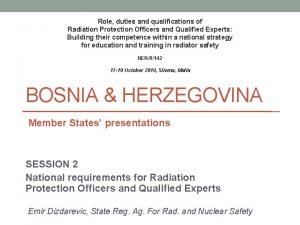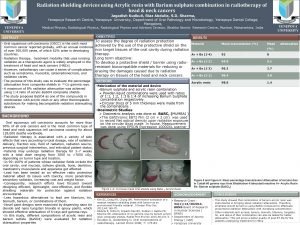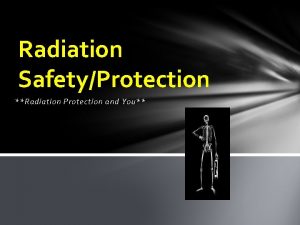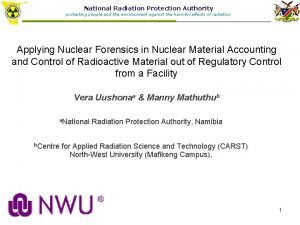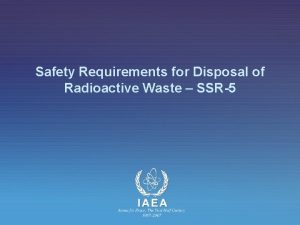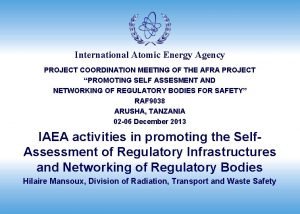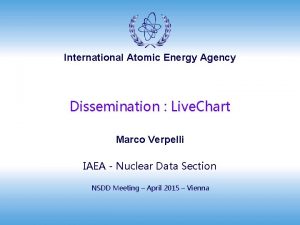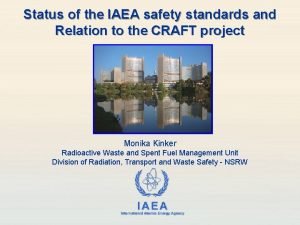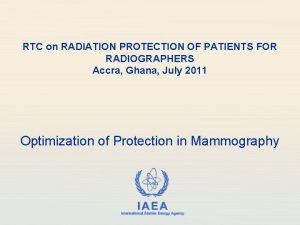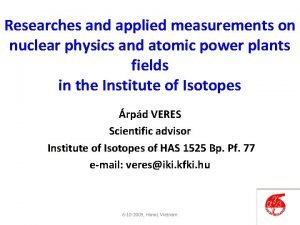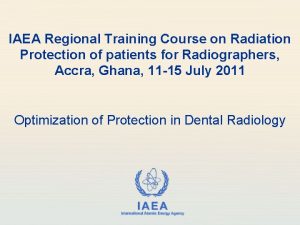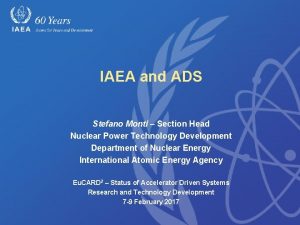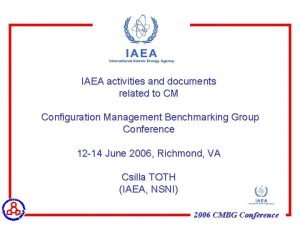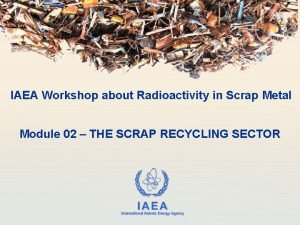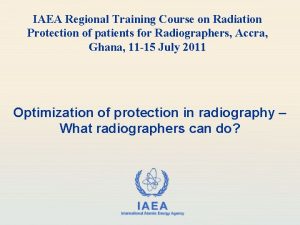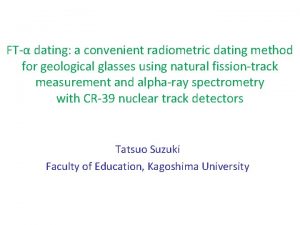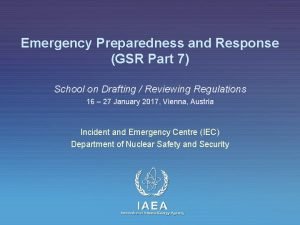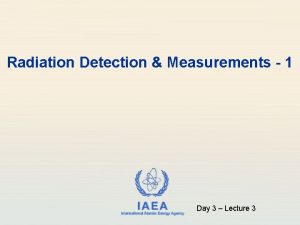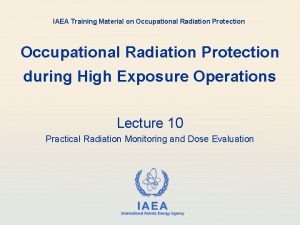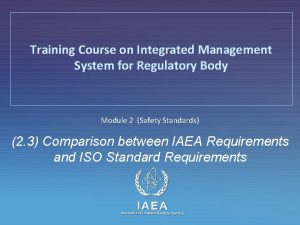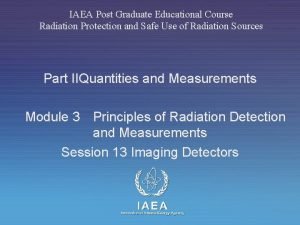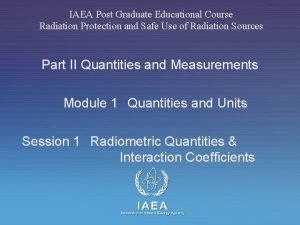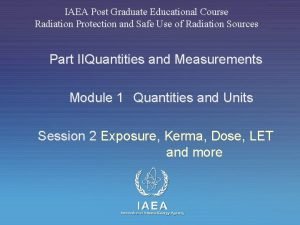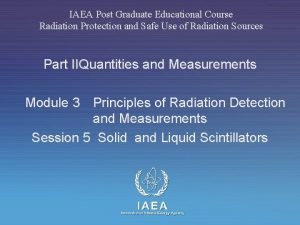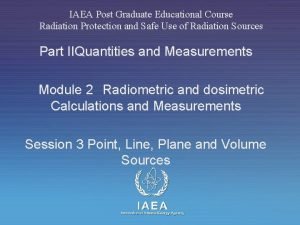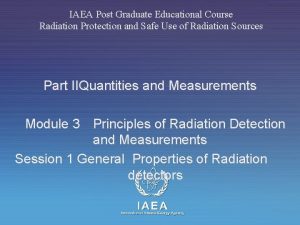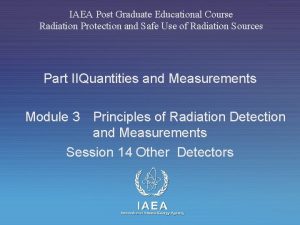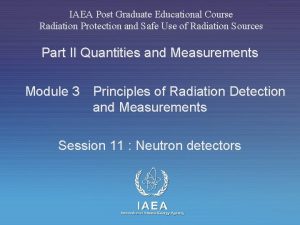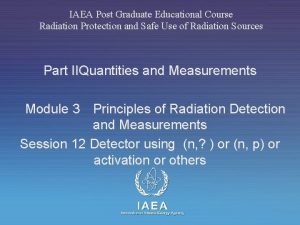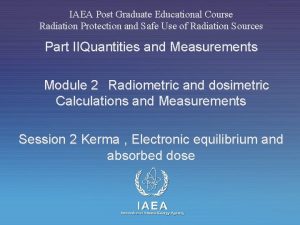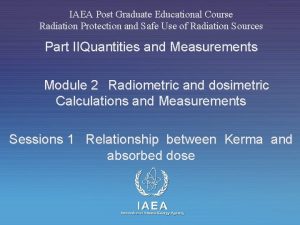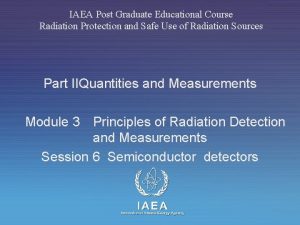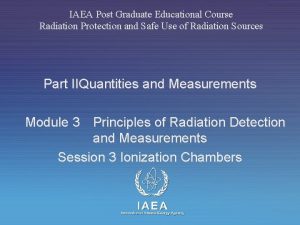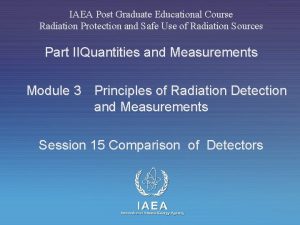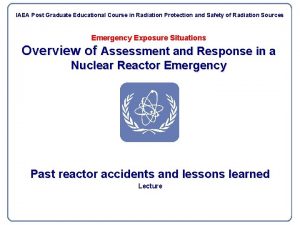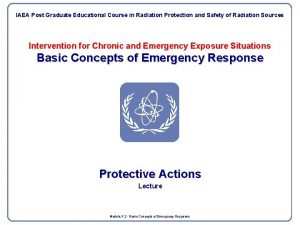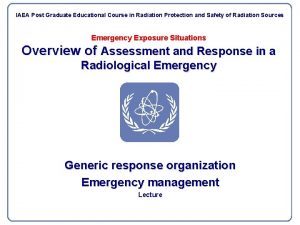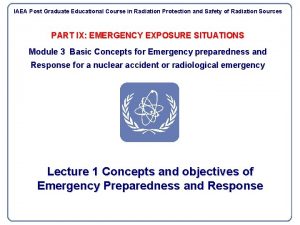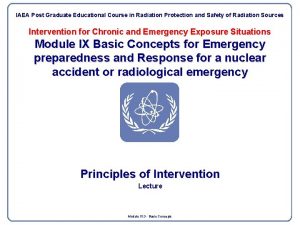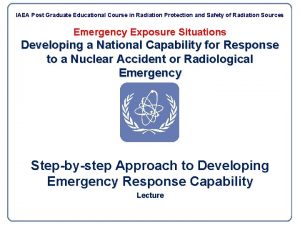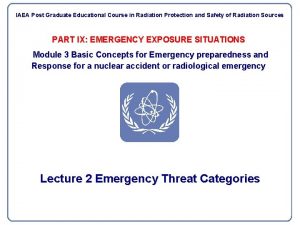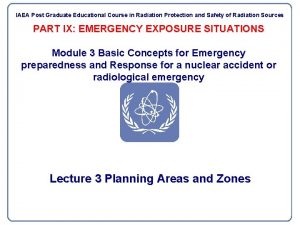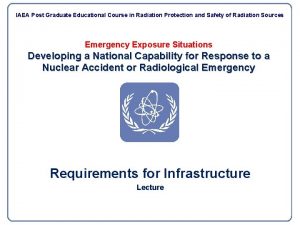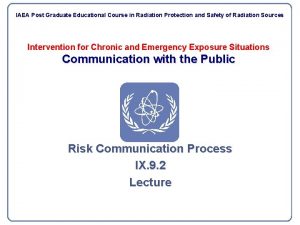IAEA Post Graduate Educational Course Radiation Protection and




























- Slides: 28

IAEA Post Graduate Educational Course Radiation Protection and Safe Use of Radiation Sources Part IIQuantities and Measurements Module 3 Principles of Radiation Detection and Measurements Session 4 Scintillation detectors IAEA International Atomic Energy Agency

Scintillation Detectors • Upon completion of this section, the student will be able to: • Explain the scintillation process • Explain how scintillation detectors may be used to determine the radionuclide and associated activity • Describe how scintillation detectors are used to detect alpha, beta, and gamma radiation IAEA 2

Scintillation Theory ü Scintillation is a means of detecting the presence of ionizing radiation ü Ionizing radiation interacts with a scintillator which produces a pulse of light ü This light interacts with a photocathode which results in the production of an electron ü The electron is multiplied in a photomultiplier tube that has a series of focused dynodes with increasing potential voltage which results in an electrical signal IAEA 3

Scintillation Detector (gamma) PHOTOELECTRONS PHOTONS (VIS. OR U. V. ) DYNODES COLLECTOR ELECTRICAL SIGNAL OUTPUT INCIDENT RADIATION PHOTO CATHODE FLOURESCENT MATERIAL IAEA PHOTOMULTIPLER TUBE 4

Scintillation Theory ü The number of counts is dependent on the activity that is present ü The energy of the electron, and consequently the associated current is proportional to the incident energy of the ionizing radiation ü By analyzing the energy and corresponding number of counts, the nuclide and activity may be determined IAEA 5

Scintillators • Scintillators may be used to detect various types of radiation • They are made of either inorganic or organic materials (plastic) • Inorganic materials have a higher light output, but have a slow response • Organic scintillators have a lower light output but have a faster response IAEA 6

Scintillators • The scintillator is optically connected to a photomultiplier (PM) tube • The height of the output pulse of the PM tube is analyzed by a mulitchannel analyzer • Alpha particles may be detected by placing a thin layer of a scintillator, zinc sulfide (Zn. S) • Photons interactions are detected using a scintillator made of sodium iodide (Na. I) or of plastic IAEA 7

Scintillation Detector (alpha) IAEA 8

Alpha Scintillation Detector The photomultiplier tube is located in the handle. IAEA 9

Scintillation Detection (photon) IAEA

Typical Gamma Spectrum Shape IAEA

Gamma Spectrum E = h 0. 511 1. 02 (E - 0. 511) (E - 1. 02) Energy (Me. V) IAEA 12

Spectral Analysis • Scintillation detectors, when used with a multichannel analyzer (MCA) provide information on the energy of a photon that has interacted with the detector as well as the activity present • The spectra can be analyzed to determine which isotopes are present IAEA 13

Single Channel Analyzer (SCA) Schematic Detector PM Tube Preamp Amplifier Single Channel Analyzer Scaler HV Power Supply IAEA 14

Multichannel Analyzer (MCA) Schematic Detector PM Tube Preamp Amplifier Multi Channel Analyzer HV Power Supply IAEA 15

Resolution The resolution of a detector is the ability to distinguish between peaks (for an MCA). The resolution is measured as the width of the peak, called the full width at half maximum (FWHM). Resolution, R, is expressed as a percentage (%): E R= x 100% FWHM EMAX Typical values for a Na. I detectors are 7% to 9% IAEA 16

Resolution 1200 1000 R= Counts 800 405 -375 390 E(MAX) = 390 (100) = 8% FWHM = E = 405 -375 600 400 200 0 340 360 375 380 390 400 Channel Number IAEA 405 420 440

Examples of Radionuclides Analyzed by Spectroscopy Nuclide Peak Energy (Me. V) Sodium-24 2. 75, 1. 37 Potassium-40 1. 46 Cobalt-58 0. 81 Cobalt-60 Iron-59 Iodine-131 Cesium-137 Zinc-65 1. 17, 1. 33 1. 10, 1. 29 0. 365 0. 662 1. 12 Source Activation Natural Activation Fission Activation Peak energies are approximate IAEA 18

Spectrum Analysis • Confirmation of the presence of a nuclide requires identification of a peak for that nuclide • Selecting peaks for this determination requires: • that the peaks be unique for that isotope • that peaks be adequately separated so they may be identified • that there is sufficient abundance for that peak • The 0. 511 Me. V peak is not desirable for identifying isotopes since it is an annihilation peak caused by pair production IAEA 19

Sample Scintillation Instruments ü The following slides provide a sample of scintillation instruments commercially available in the United States ü More detailed information concerning these and other instruments may be obtained by visiting the websites of some of the major manufacturers such as Ludlum, Eberline and Bicron IAEA 20

Bicron Micro Rem Meter This lightweight, low level instrument uses a tissue equivalent scintillation detector to make rapid measurements of absorbed dose rate down to background levels. High sensitivity and true dose response sets them apart from other GM or Na. I based survey meters and makes them ideal for confirming the boundaries of radiation zones wherever radiation fields occur. Low energy and extended detector options are available. Five linear ranges 0 -20 rem/h to 0 -200 mrem/h; 90% response time <15 sec Energy response 17 ke. V to 1. 3 Me. V with low density window option IAEA 21

Eberline Model PM 7 “Portal Monitor” FEATURES: Microcomputer controlled Automatic background subtraction RS-232 serial communications port Six large plastic scintillator detectors SENSITIVITY: RDS for a 0. 4 second walk through is approximately 100 n. Ci RDA for a 10 second stop and count is approximately 0. 4 n. Ci Annunciator Lights for Contamination alarm, Ready, Recount, Out of Service Human Silhouette to indicate contamination area SIZE: 228. 6 x 101. 6 x 50. 8 cm WEIGHT: 400 kg excluding lead shielding [800 kg with lead shielding ] POWER: 105 to 125 Va, 47 to 63 Hz, 1 A BATTERY BACKUP: 8 hours operation OPERATING TEMP: 0 to 50 C IAEA 22

Ludlum Model 44 -3 25 mm X 1 mm Na. I(Tl) Gamma Scintillator for low energy gamma (LEG) INDICATED USE: I 125 and x-ray survey SCINTILLATOR: 1" (2. 5 cm) diameter X 1 mm thick (Na. I)Tl scintillator ENTRY WINDOW: 15 mg/cm 2 WINDOW AREA: 5 cm 2 active and open RECOMMENDED ENERGY RANGE: Approximately 10 - 60 ke. V BACKGROUND: Typically 40 cpm/micro. R/hr SENSITIVITY: Typically 675 cpm/micro. R/hr (I 125) EFFICIENCY(4 pi geometry): Typically 19% - I 125 TUBE: 3. 8 cm diameter magnetically shielded photomultiplier OPERATING VOLTAGE: Typically 500 - 1200 volts CONSTRUCTION: Aluminum housing with beige polyurethane enamel paint TEMPERATURE RANGE: (-20 o. C) to (50 o. C) SIZE: (5. 1 cm) diameter X (17. 8 cm)L WEIGHT: 0. 5 kg IAEA 23

Eberline LEG-1 Application: Low Energy Gamma optimized for 125 I Detector Type: 1" diameter by 0. 04" thick Na. I(Tl) Window: 75. 4 mg/cm 2 aluminum window Sensitive Area: 0. 79 inch 2 Operating Voltage: 1, 000 V nominal Dead Time: 8 s nominal Background Sensitivity: ~ 60 cpm/m. R/h (137 Cs) Energy Response/Photon: ~ 95% 125 I Energy Range: ~ 15 to 200 kev Operating Temp: -30 o to +60 o C Housing: Aluminum body Size: 4. 2 x 20. 1 cm Weight: 340 g IAEA 24

3 Scintillator Models Specs 380 A 380 B 380 AB Application Alpha Beta Alpha/Beta Zn. S Beta Scintillator Dual Phosphor Detector Efficiency 21% (239 Pu) (4 ) 22% (90 Sr/Y) 9% (99 Tc) 18% (239 Pu) (see Beta) (Remaining specifications common to all) Voltage Area 600 V 100 cm 2 Thickness 0. 87 mg/cm 2 Sensitivity 12, 000 cpm/m. R/hr Temperature IAEA -40 to +60 o. C Housing Connector Size Weight Al MHV 29. 2 x 7 x 8. 3 cm 0. 59 kg 25

Eberline FCM-4 “floor monitor” The FCM 4 floor contamination monitoring system performs continuous surveying of flat terrain areas in a one person operation. Using thin plastic scintillation detectors, this highly sensitive monitor exhibits low gamma background response and does not require the maintenance of gas proportional systems. The FCM 4 features four 8" x 6" dual phosphor detectors for alpha/beta detection. A laptop displays activity and survey speed in digital and bar graph forms. Survey speed is integrated, so that count time is adjusted automatically in maximum sensitivity mode. In minimum count time mode, an alarm sounds when the monitor moves too fast for an acceptable count time. In stop-andcount mode, the display indicates when the FCM 4 has traveled one detector length, i. e. , positioned for the next count. IAEA 26

Eberline FCM-4 “floor monitor” (cont) Detectors: 4 dual-phosphor scintillators, Zn. S and plastic Area: 8" L x 24" W total area (1240 cm 2) Thickness: 0. 75 mg/cm 2 window (screen 83% open) Sensitivity: 500 dpm alpha & 2, 000 dpm beta 137 Cs, depending on speed Interface: Laptop computer mounted - semi-automatic calibration, independent detector control, data logging. Count Modes: Maximum sensitivity, minimum count time, stop-n-count, background Detector Height: Adjustable to 5" in 10 log steps Power: Rechargeable batteries, approximately, 8 hours operation Dimensions: 35" L x 27" W (excluding handle) Weight: 68 kg IAEA 27

Ludlum Model 3 Survey Meter 3 COMPATIBLE DETECTORS: GM, scintillation METER DIAL: 0 - 2 m. R/hr, or 0 - 5 k cpm, BAT TEST MULTIPLIERS: X 0. 1, X 10, X 100 LINEARITY: Reading within 10% of true value HIGH VOLTAGE: Adjustable from 200 - 1500 volts RESPONSE: fast (4 sec) or slow (22 sec) from 10 to 90% of final reading BATTERY LIFE: 2000 hours with alkaline batteries TEMPERATURE RANGE: -20 to 50 o. C SIZE: 16. 5 cm H X 8. 9 cm W X 21. 6 cm L WEIGHT: 1. 6 kg including batteries 14 C MULTIPLIERS: X 0. 1, X 10, X 1000 INTERNAL DETECTOR: Energy compensated GM (used with X 1000 scale only) ENERGY RESPONSE: 15% 0. 06 -3 Me. V (internal detector) HIGH VOLTAGE: 900 volts BATTERY LIFE: 600 hours with alkaline batteries IAEA 28
 Radiation protection officer qualifications
Radiation protection officer qualifications Barium sulphate board for radiation protection
Barium sulphate board for radiation protection Cardinal principles of radiation protection
Cardinal principles of radiation protection National radiation protection authority namibia
National radiation protection authority namibia Ssr 5
Ssr 5 Saris iaea
Saris iaea Iaea livechart
Iaea livechart Iaea pcmf
Iaea pcmf Part5ds
Part5ds Iaea
Iaea Iaea
Iaea Iaea
Iaea Stefano monti iaea
Stefano monti iaea Iaea
Iaea Iaea
Iaea Iaea
Iaea Iaea
Iaea Iaea
Iaea Gsr part 7
Gsr part 7 Pcmf
Pcmf Film badge
Film badge Iaea
Iaea Iaea gsr part 2
Iaea gsr part 2 Disclaimer slide for presentation
Disclaimer slide for presentation Course number and title
Course number and title Post merger integration presentation
Post merger integration presentation English bond t junction elevation
English bond t junction elevation Course interne course externe
Course interne course externe Degree plan ogaps
Degree plan ogaps
